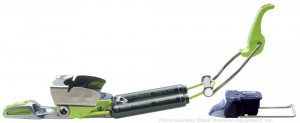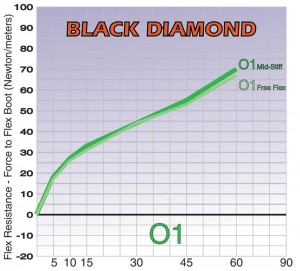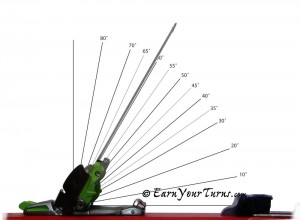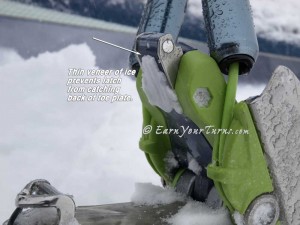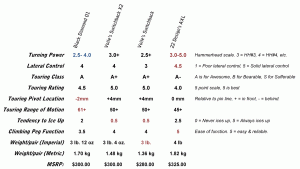To say that Black Diamond’s O1 is the most popular telemark binding in America for earning turns is to acknowledge reality. There are several reasons for that popularity, not the least of which is the fact that the O1 was the first telemark binding with a free pivot that also, finally, delivered enough power to adequately drive fat skis.
Other bindings made it to market with a free-pivot sooner, but they were under powered and skis were only getting wider, boots taller, and aspirations higher.
The O1 builds upon the platform established with the O2, using a pair of compression spring cartridges routed underneath your boot, for fast turn engagement. It was the first touring specific binding that came close to equaling the Hammerhead for turning power. It is no longer the most powerful telemark touring binding on the market, but not all telemarkers want or need that level of power to control their skis.That is one of the beauties of the O1. You can vary the tension in the cable by changing the spring cartridges underfoot. Three tensions are available: Free-flex, Mid-stiff, and Ridiculously stiff. For most folks the mid-stiff spring offers a smooth, more than adequate tele-resistance for driving mid-fat skis with four or three buckle boots. It isn’t so stiff that it causes your tips to dive in powder either. If you ski fast with big boots and phat skis, you’ll probably be happiest with the rid-stiff springs. Besides taking more time to adjust the spring power, you may have to buy a second pair of springs since the bindings only come with one pair. In a side by side comparison with Hammerheads, mid-stiff springs felt like HH#3, and the rid-stiffs like HH#4, although there is a difference in the feel between the two bindings, it is subtle and hard to describe. For raw tele power there are more powerful bindings available. However, contrary to BD’s own motto, the O1 is popular because it’s not all about the down.
Even though the O1 rocks on the downhill, it rules on the uphill. This becomes immediately evident when you go to switch modes from a locked to a frictionless free pivot. The O1 is the most intuitive mode switch out there. To unlock the toe, simply put the tip of your ski pole in the rear dimple of the green toggle switch at the front of the binding, give ‘er a smack, and presto, your toe plate swings free.
That is but one reason it rules on the uphill. The other is the range of motion, over 60°+ which gives plenty to spare in the rare case where snow builds up underneath the duckbill. Thus it never hinders the movement needed to pull off a tight switchback on a steep and deep trail, even on the ice prone wet coast.When you switch back to turn mode you don’t have to concern yourself with keeping your foot flat like you do with 7tm or G3’s Ascent. If your heel is raised when you toggle the switch back, just step down and the latch will catch the back of the toe plate once it’s seated.
At 3 lbs, 12 oz. (1.7 kg) per pair it is not the lightest tele binding available, nor the heaviest. The touring pivot point is located a few millimeters behind pin line, for a more efficient stride. This is not something you will notice on a short climb, but may on a long one.
One thing you are certain to notice is the tendency for the binding to ice up when skinning. Saying the binding ices up is actually a misnomer since it rarely becomes choked with ice preventing the latch from holding the toeplate down. What happens instead is much more subtle, but equally effective at preventing the toeplate from locking down. A thin layer of snow gets packed on the underside of the toe plate, creating a shim of ice that prevents it from seating low enough for the latch to hook on and hold the back of the toe plate. How often this occurs is dependent on the snow condition you tour in. On the wet coast it probably happens 10-20% of the time overall, but when the snow is sticky it happens a lot. In drier ranges it is pretty rare. To cure it, reach under and wipe that thin sheath of ice off and the latch will do its job quickly and securely. That’s the most annoying blemish to the O1’s overall report card. There are others, but far fewer people notice or experience them (see pg 2). When you consider how easy the mode switch is to operate, the large range of free-pivot motion and a three choices for downhill power there is much to like and little to quibble about. So unless you absolutely must have the most powerful binding, or the lightest, telemarkers can hardly go wrong with the O1.Black Diamond
O1
MSRP: $300
Weight (std): 3 lb. 12 oz. (1.73 kg)
Standard size springs fit Mondo 25 – 31. Small springs fit < mondo 25
ROM: 61°+
Choice of three spring cartridges: Free-Flex, Mid-Stiff, Rid-Stiff
Optional ski crampons
© 2011
Adjusting BD's O1 Telemark Binding

